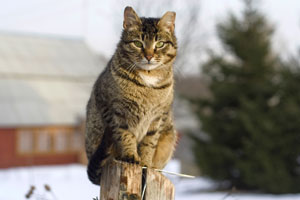Extreme cold weather safety tips for feral and stray cats
Alley Cat Allies, the national advocate for feral and stray cats, is offering tips for helping feral and stray cats as the nation experiences severe freezing temperatures and strong winds.
“As the temperatures continue to plummet and winds increase around the country, it is vital that we take extra steps to ensure the health and safety of outdoor cats,” said Becky Robinson, president of Alley Cat Allies.

To help the feral and stray cats in your community hunker down during extreme cold and bitter weather, Alley Cat Allies suggests the following simple steps:
Provide an outdoor shelter and a refuge from the bitter cold and winds.
Shelters are easy and inexpensive to build. You can use the plans available at www.alleycat.org/WinterWeather, or modify a pre-built dog house. Some manufacturers also sell pre-built cat shelters.
The shelter should be elevated off the ground and sited in a quiet, unobtrusive area with a minimal amount of traffic. A good-sized shelter offers a space just big enough for three to five cats to huddle. The door should be no more than six to eight inches wide to keep out wildlife and bigger predators. Install a flap on the door to keep out snow, rain and wind.
In addition to a shelter, you can build a simple feeding station with a roof and sides to protect cats from the elements while they eat.
Insulate the shelter against moisture as well as cold.
Straw resists the wet and keeps a shelter warm, and is the best choice for insulation and bedding. Blankets are not a good idea, as they absorb moisture like a sponge.
If you have a shed or garage, allow cats to have access during winter and severe weather. But remove dangerous anti-freeze products which are lethal to animals when consumed.
Provide fresh water daily and additional food. In extreme cold weather cats require fresh water twice a day to prevent dehydration and larger food portions. Wet food in insulated containers is ideal for wintertime feeding, as it takes less energy for cats to digest than dry food-and cats can use that extra energy to keep warm.
You can apply foam insulation to the hollow underside of a regular plastic feeding dish. This can delay the freezing of food and water. Preventing liquids from freezing can be a challenge during the winter.
To fend of dehydration, keep water drinkable by:
- Using bowls that are deep rather than wide, and place them in a sunny spot.
- Refilling the bowls with hot or warm water.
- Adding a pinch of sugar to the water; this keeps it from freezing as quickly and provides an energy boost for the cats!
- Purchasing heated electric bowls found in many pet shops.
Keep the cats on a regular feeding schedule. The cats will come to expect the food and water and will spend less time in the cold before being consumed.
Also remember to clear your pathways. Cats will find shelter, whether you have provided a man-made winter shelter or the cats will find their own protection from the elements.
With heavy snowfall it is important to clear snow away from entrances/exits of shelters. The cats can get “snowed in.” Regularly shoveling pathways makes it easier to stay ahead of accumulation. Shelter entrances should be blocked from wind.
Alley Cat Allies does not recommend using salts or chemicals designed to melt snow near colonies. These products can be toxic and injure cats’ paws. There are specific “pet safe” sidewalk melting salts available made of magnesium chloride, including Road Runner Pet Friendly Ice Melt and Mag, but it is still possible for cats to drink water out of melting puddles containing chemicals.
Before you drive, check under the car before you start it. Cats will sometimes crawl into the engine area or hide underneath for warmth. Give the hood of your car a tap, to scare out any cats that may be underneath that you didn’t see. Remember that antifreeze is lethal to cats and other animals. Keep it out of reach!
More information about winter safety for outdoor cats can be found at www.alleycat.org/WinterWeather.

